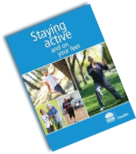These are any activities that challenge your muscles. They help to maintain bone and muscle strength, which supports healthy function and independence. Aim to do some strength exercises 2 to 3 times per week.
Strength activities you can try, include:
- exercises using your body weight (like push-ups, sit-ups and squats), exercise bands, or gym equipment (like dumbbells and resistance machines)
- lifting and carrying things (like your groceries)
- moderate yard work (like digging and shifting soil)
- climbing stairs.
Progressive resistance training is an important type of strength training designed to improve muscle strength and size. Progressive resistance training refers to progressively adding resistance to your muscles so that they become stronger.
Examples you can try, include:
- Exercises using resistance bands, ankle weights or dumbbells
- Weight machines (example, leg press, chest press)
Progressive resistance training can be performed at home with minimal, inexpensive equipment, such as resistance bands, ankle weights and dumbbells or by using your own body weight as resistance.
To get the best strength and mobility outcomes, undertake supervised resistance exercise. Also, use equipment that allows you to progress and increase the intensity of your exercise.
Your muscles will only get significantly stronger with specific resistance exercises at an intensity that challenges them more than your usual day-to-day activities.


